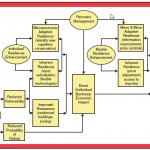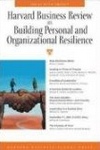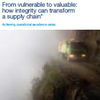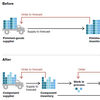 The recent earthquake in Haiti is a poignant reminder of how vulnerable a country is when it is facing disaster on a grand scale. To me, it is a reminder that that while natural disasters are not man-made, the aftermaths and consequences of the disasters often are. Disasters like this call for resilience in all parts of the community, including the infrastructure, the supply chains and society as a whole. Some of the older posts on this blog , and which do not see daylight too often may shed some light on this.
The recent earthquake in Haiti is a poignant reminder of how vulnerable a country is when it is facing disaster on a grand scale. To me, it is a reminder that that while natural disasters are not man-made, the aftermaths and consequences of the disasters often are. Disasters like this call for resilience in all parts of the community, including the infrastructure, the supply chains and society as a whole. Some of the older posts on this blog , and which do not see daylight too often may shed some light on this.
Prepare or react?
 The first post that comes to mind is from July 2009, when I happened to watch the BBC World Debate aptly titled “Disasters – Prepare or React?” The question was, should we actually bother to spend time and money on disaster mitigation, or should we rather focus on preparing for disaster recovery? Is re-active better than pro-active? Should governments spend large sums of money on mitigation, on building up rescue and recovery capabilities, or should we rather tell people how can they can survive as long as possible if no rescue arrives, and in that manner reduce the impact? The basic message was that the government can only do so much, you have to do the rest yourself. On the other hand, the government must also provide the funds and opportunities, the legal and economical framework, for communities to prepare themselves.
The first post that comes to mind is from July 2009, when I happened to watch the BBC World Debate aptly titled “Disasters – Prepare or React?” The question was, should we actually bother to spend time and money on disaster mitigation, or should we rather focus on preparing for disaster recovery? Is re-active better than pro-active? Should governments spend large sums of money on mitigation, on building up rescue and recovery capabilities, or should we rather tell people how can they can survive as long as possible if no rescue arrives, and in that manner reduce the impact? The basic message was that the government can only do so much, you have to do the rest yourself. On the other hand, the government must also provide the funds and opportunities, the legal and economical framework, for communities to prepare themselves.
Economic Resilience
 In another post, dated as far back as may 2008, I reported on how to define and measure economic resilience, a paper published by the Multidisciplinary Center for Earthquake Engineering Research (MCEER), refers to the inherent and adaptive responses to hazards that enable individuals and communities to avoid some potential losses. It can take place at the level of the firm, household, market, or macroeconomy. In contrast to the pre-event character of mitigation, economic resilience emphasizes ingenuity and resourcefulness applied during and after the event.
In another post, dated as far back as may 2008, I reported on how to define and measure economic resilience, a paper published by the Multidisciplinary Center for Earthquake Engineering Research (MCEER), refers to the inherent and adaptive responses to hazards that enable individuals and communities to avoid some potential losses. It can take place at the level of the firm, household, market, or macroeconomy. In contrast to the pre-event character of mitigation, economic resilience emphasizes ingenuity and resourcefulness applied during and after the event.
Personal and Organizational Resilience
 Strangely enough, I have just started reading the Harvard Business Review on Building Personal and Organizational Resilience
Strangely enough, I have just started reading the Harvard Business Review on Building Personal and Organizational Resilience, a book I will review later. While none of the essays contained in the book deals with natural disasters as such, one of essays excellently highlights the key ingredients of resilience: 1) Reality. In the bitter end, it is not optimism that will see you through a crisis, but realism and down-to-earth views what matters for survival. 2) Meaning. Do not ask “Why” things happen, ask “Why not?” and build a bridge from the present hardships towards a brighter future. 3) Ingenuity. Make do with whatever is at hand, be a Mac Gyver, the ultimate in resilience (although the word “resilience” probably never featured even once in the TV series).
Emergency Logistics
I should also mention a recent article on Emergency Logistics that looks at logistics and risk mitigation in Thailand following the Asian tsunami, Interestingly, the Thai Disaster Prevention Master plan only implicitly underscores the need for logistics requirements, but does not state them explicitly. On the other hand, local and regional responsibilities for preparedness and response are clearly stated, mentioning that key supplies are necessary, but leaving it up to the local agencies to acquire whatever is necessary, should the need arise. Make do with what you have.
When disasters strike
…how does the transportation network recover? That was the topic of a session I attended at TRB 2009 this week last year. Although the session was mainly aimed at US transportation agencies, some key of the points work regardless of location: recovery plans need to be broad, they must include all possible hazard events and all transportation modes. Transportation recovery plans need to look beyond their mere purpose of addressing hazards in the transportation network. The transportation network is essential to many communities. This implies that the restoration of the transportation network also means the restoration of the economy and the society, not just the infrastructure.
And Haiti?
Unfortunately, Haiti is an impoverished country, one of the world’s poorest and least developed. Resilience, albeit on a different scale and with different notions of survival than in the strictest business sense, are most likely part of the daily struggle. I’m sure that Haiti will recover, but it’s going to be a slow process. Very slow.
Further reading
More on this topic can be found on this blog under “resilience“, or on Ken Simpson’s blog Contemplating…, particularly his most recent posts that summarizes some of his ponderings on resilience.
Related
- husdal.com: Disasters – Prepare or React?
- husdal.com: Economic resilience
- husdal.com: When disasters strike












